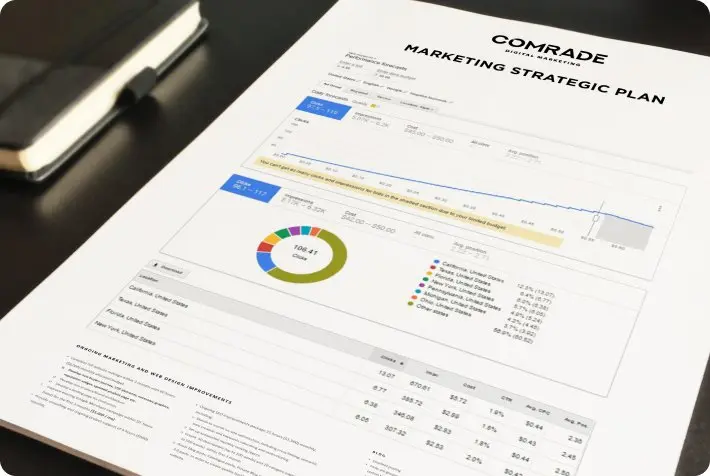You’ve spent years becoming an expert in bankruptcy law. Now it’s time to make sure clients can find you when they need you most. Mastering bankruptcy lawyer SEO is crucial for effective law firm marketing, ensuring your expertise reaches those in need of your bankruptcy services.
Here’s the hard truth: If your bankruptcy firm doesn’t show up on the first page of Google, you’re missing out on clients every single day. Research shows that 75% of people never look past the first page of search results.
Today’s searchers aren’t carefully reading through all the search results either. They’re using Google’s AI summaries for quick answers when they search things like “bankruptcy lawyer near me” or “how to stop home foreclosure quickly.”
In this guide, we’ll share 10 tested SEO strategies specifically for bankruptcy attorneys to increase your visibility, attract qualified clients, and stay competitive in today’s AI-driven world.

How Bankruptcy Lawyers Can Succeed in a Competitive Market
Picture this: Someone drowning in debt in your city searches for “bankruptcy attorney near me.”
If your firm doesn’t appear but your competitor does, you’ve lost a potential client without even knowing they existed. This happens to most bankruptcy law firms in 2026. Effective SEO for bankruptcy is crucial for standing out in a competitive market, as it helps improve online visibility and attract potential clients searching for bankruptcy-related legal assistance.
Why SEO for Bankruptcy Lawyers is Critical in Today’s Digital Age
- 92% of people use Google first when looking for legal help.
- 66% of clients do online research before contacting a lawyer.
- 75% of users only look at the first page of search results.
For bankruptcy attorneys, these numbers are crucial. When someone faces wage garnishment, overwhelming credit card debt, or is considering bankruptcy, they’re going through one of the most stressful financial situations of their life. They need help right away, and they’re using Google to find it. Improving search engine rankings is crucial for being found by clients in need.
It’s About Being Found When Clients Need You Most
Good SEO helps your bankruptcy practice:
- Appear during financial emergencies. When creditors are calling or foreclosure notices arrive, people turn to Google immediately. SEO ensures your firm shows up exactly when they’re looking for help, enhancing your online visibility.
- Build trust before the first meeting. When you regularly provide helpful information about bankruptcy options, debt relief strategies, and exemptions, potential clients see you as an expert they can trust.
- Get quality leads without constant ad spending. SEO works all the time, unlike paid ads that stop when your budget runs out.
How AI Is Changing How Bankruptcy Clients Find You
Search isn’t what it used to be. Tools like Google SGE, Bing AI, and ChatGPT now give users instant, AI-generated answers—no scrolling or clicking required. For bankruptcy lawyers, this major shift means traditional SEO tactics alone aren’t enough anymore.
These AI systems decide which bankruptcy firms get shown in search engine results and which get ignored based on content quality, website structure, and trust signals. If your content isn’t optimized for AI search, even if you’re the most experienced bankruptcy attorney in town, you might be invisible online.
That’s right. Even if you’ve successfully handled thousands of bankruptcy cases, AI could make you virtually invisible to potential clients.
This Guide Will Give You a Competitive Edge
We’re about to show you what works for bankruptcy lawyers in 2026—from basic SEO fundamentals to advanced AI strategies—to help your firm rank higher, get more qualified consultations, and stay ahead of competing bankruptcy practices.
New to SEO? You’re not alone. Get clear, straightforward answers to common law firm SEO questions in our quick-start guide.
1. Develop a Focused SEO Plan for Your Bankruptcy Practice
Before jumping into optimization, you need a solid plan. An effective marketing strategy for bankruptcy attorneys isn’t just about higher rankings—it’s about connecting with clients who need your specific bankruptcy expertise. Start with these three key steps:
Define Your Success Metrics
Know what you want to achieve before you begin so you can track your progress. Defining success metrics helps in creating custom SEO solutions tailored to your goals. Ask yourself:
- Are you looking to handle more Chapter 7 cases?
- Do you want to increase Chapter 13 reorganization filings?
- Is your goal to drive more traffic to pages about bankruptcy alternatives?
Understand Your Potential Clients’ Search Habits
Next, learn what prospective clients facing financial hardship are actually typing into search engines:
- What financial breaking points finally push them to look for legal help?
- What specific questions do they search for before considering bankruptcy?
- What misunderstandings do they have about bankruptcy proceedings?
Tools like Google Search Console, AnswerThePublic, and even ChatGPT can reveal the exact phrases and underlying intentions behind these searches.
Study Your Top-Ranking Competitors
Examine the bankruptcy firms that dominate search results in your area:
- What bankruptcy topics do they cover that you haven’t addressed?
- How do they organize their Chapter 7 and Chapter 13 pages and incorporate keywords?
- Are they targeting keywords related to location-specific bankruptcy exemptions?
- What target keywords are they focusing on that you might have missed?
Resources like Semrush, Ahrefs, and SpyFu can show you their best-performing content, backlink sources, and keyword approaches.
Pro Tip for AI Use: Ask ChatGPT or Claude to analyze a competitor’s bankruptcy blog or service page to identify content gaps and opportunities to provide better, more targeted information.
For instance, if competing firms are covering “How bankruptcy affects your credit score in [your state]” but you aren’t, that’s an opportunity to create valuable content.
Build your strategy around addressing your bankruptcy clients’ actual concerns, not just what might please search engines. When you directly address their financial worries and needs, better rankings will follow naturally.
2. Master Keyword Research for Bankruptcy Legal Services
The foundation of effective bankruptcy SEO is understanding exactly what your potential clients are searching for and creating content that meets those needs. In-depth keyword research isn’t just a task to complete—it’s the backbone of your entire strategy.
Research shows that organic search drives over 50% of website traffic, with high-intent terms converting best. Local keywords are particularly valuable—“near me” searches have increased by more than 900% in recent years.
Focus on High-Intent, Local Bankruptcy Keywords
Someone searching “what happens in bankruptcy” is probably just exploring options. But someone who searches “bankruptcy lawyer in Miami who handles foreclosures” is ready to hire. Your priority should be targeting these action-oriented and relevant keywords.
Look for phrases like:
- “Emergency bankruptcy attorney [your city]”
- “Stop wage garnishment lawyer near me”
- “How to protect my house in Chapter 13 bankruptcy in [your state]”
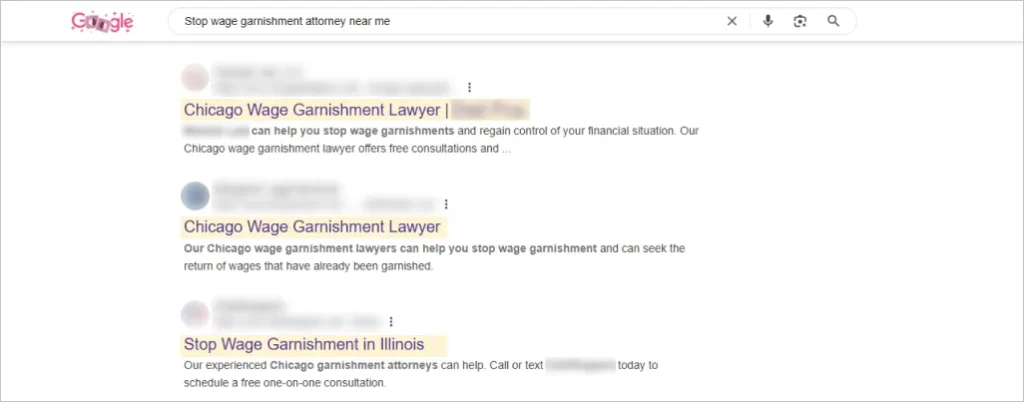
Thorough keyword research is essential to discover the specific terms that potential clients use when looking for bankruptcy legal help.
Use Effective Tools (Including Your Client Intake Notes)
Instead of guessing, rely on a keyword research tool like:
- Google Keyword Planner
- Ahrefs and Semrush (to monitor competitors)
- AnswerThePublic (for real-world search questions)
- Google Search Console (to identify your current successful keywords)
Practical Tip: Review what bankruptcy clients say during consultations and on intake forms—these exact words and phrases are likely what future clients are searching for.
Target Specific Keywords Rather Than Just Competitive Ones
General terms like “bankruptcy lawyer” face extreme competition. Instead, target more specific phrases like “how to file emergency bankruptcy to stop eviction in [your state]” or “can I keep my car after filing Chapter 7 in [your state]?”
Tools like ChatGPT or Frase can help generate clusters of question-based keywords. Try asking: “List 20 things someone might search for before hiring a bankruptcy lawyer in [your state].” This quickly reveals real client concerns, which you can then address in your content.
3. Optimize Your Pages for Bankruptcy SEO Success
You might be the most qualified bankruptcy attorney in your area, but if your website structure is confusing or your page titles are weak, Google won’t rank you highly, and potential clients won’t click.
Website optimization is crucial for driving visibility. It helps search engines understand your bankruptcy expertise and shows potential clients why they should trust you during their financial crisis.
Create Compelling Titles and Descriptions
Your title tag makes your first impression on search engine results pages.
Avoid generic titles like “Home | Smith Bankruptcy Law.”
Instead, use: “[Your City] Bankruptcy Attorney | Stop Foreclosure Today | Smith Law”
Follow with a meta description that emphasizes urgency and value: “Facing foreclosure or wage garnishment? Our [your city] bankruptcy team can stop creditors today. Free same-day consultations available.”
Remember to keep titles under 60 characters and meta descriptions under 160 characters.
An effective approach includes creating titles and descriptions that both attract clicks and communicate the urgency and value of your services.

Structure Your Bankruptcy Content with Clear Headers
Break your content into easy-to-scan sections using header tags (H1, H2, H3):
- H1: Chapter 7 Bankruptcy Attorney in [Your City]
- H2: How Chapter 7 Can Eliminate Your Credit Card Debt
- H3: [Your City] Chapter 7 Bankruptcy Exemptions
This improves readability, enhances keyword relevance, and boosts SEO performance by creating informative and engaging content.
Create Strategic Internal Links
Guide visitors with internal links that improve navigation and SEO for your bankruptcy law firm’s website:
- Link from your “Bankruptcy Options” page to specific “Chapter 7” and “Chapter 13” pages
- Link from FAQ answers to your bankruptcy consultation page
Keep URLs Simple and Search-Friendly
Avoid: /services/bankruptcy-options-8w7%82f76
Use: /chapter-7-bankruptcy-lawyer-[your-city]
Simple and search-friendly URLs are crucial for effective search engine optimization. Tools like ChatGPT, Jasper, or SurferSEO can help you generate keyword-rich titles, meta descriptions, and header suggestions quickly.
Just be sure to review them for tone, accuracy, and compliance with legal advertising regulations.
4. Win Clients Through Valuable Bankruptcy Content
If your website content is vague, outdated, or unhelpful about bankruptcy options, you’re not just missing clicks—you’re losing trust at a critical time when potential clients need confidence the most. Valuable content is crucial for effective bankruptcy lawyer marketing, as it ensures that your audience finds the information they need clearly and straightforwardly.
Today’s bankruptcy clients research online before making a call. If your content doesn’t answer their questions about debt relief options, they’ll leave and contact a competitor who does provide helpful information.
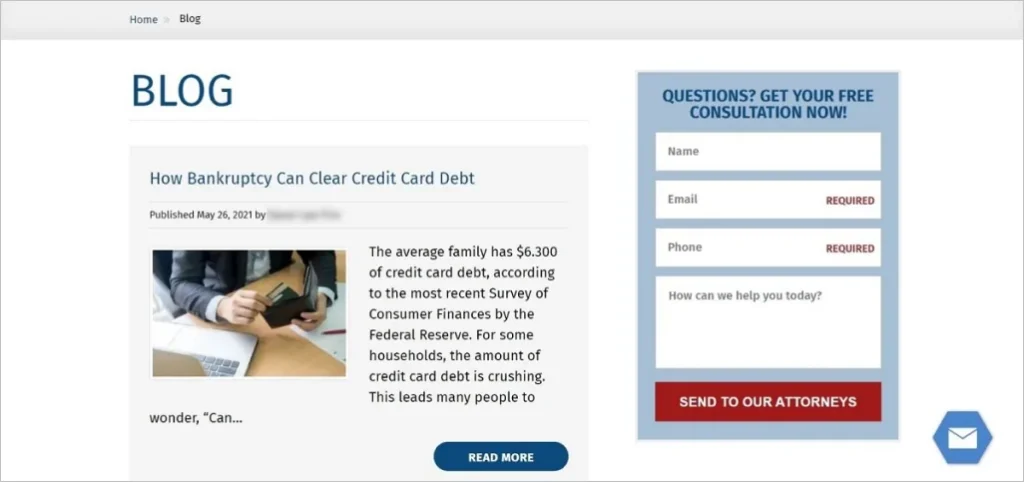
Bankruptcy Law Firm Content Strategy: Converting Visitors to Clients
Think of content marketing as developing helpful, search-optimized resources that match your client’s journey from financial distress to relief. A comprehensive marketing strategy involves creating content for each stage of this journey, ensuring all components work together effectively. We suggest starting with your main bankruptcy services and creating content for each stage:
- Awareness: “How do I know if bankruptcy is right for me?”
- Consideration: “Chapter 7 vs. Chapter 13: Which fits my financial situation?”
- Decision: “Best bankruptcy attorney in [your city] for stopping foreclosure”
Is it worth the effort? Absolutely! Nearly half of all people research legal issues online before contacting an attorney.
Develop Dedicated Bankruptcy Service Pages
Each bankruptcy service you offer deserves its landing page on your bankruptcy law firm website, not just a brief paragraph on your homepage.
Why? Because clients search with specific intent. Someone looking for a “Chapter 13 bankruptcy lawyer in [your city]” wants information specifically about reorganization bankruptcy in your state. To rank well and convert visitors, these pages should:
- Use location-targeted keywords in your title, headers, and URL (e.g., /chapter-13-bankruptcy-lawyer-[your-city])
- Answer common client questions about your state’s bankruptcy exemptions and procedures
- Include trust elements like client testimonials, case outcomes, and bankruptcy certification credentials
- End with a clear call to action (“Stop creditor harassment today – schedule your free consultation”)
Use Your Blog to Educate and Establish Bankruptcy Expertise
To build a lead-generating bankruptcy blog, focus on creating informative posts about:
- Bankruptcy law updates explained in plain language
- Asset protection strategies to consider before filing
- Local bankruptcy court procedures and judge tendencies
Share Case Studies to Attract Bankruptcy Clients & Improve SEO
To showcase your successes and persuade future clients, share well-structured bankruptcy case studies and positive reviews:
- Problem: “Family facing home foreclosure with $75,000 in credit card debt”
- Solution: “Filed Chapter 13 reorganization with custom payment plan”
- Result: “Saved their home, reduced debt by 60%, created manageable 3-year payment plan”
Encouraging satisfied clients to leave positive reviews on various platforms can significantly improve your firm’s online reputation and trustworthiness. Happy clients are likely to share their experiences with friends and family, leading to long-term brand building.
Important Reminder: For all bankruptcy content, always verify facts, cite sources when needed, and align with Google’s E-E-A-T and YMYL standards. While AI tools can help with content creation, human expertise in current bankruptcy law is essential for building trust.
5. Strengthen Your Local SEO to Beat Other Bankruptcy Firms
When someone searches “bankruptcy lawyer near me” and your firm isn’t in the top 3 local results, you’re effectively invisible. This isn’t an overstatement—research shows that 75% of users never look beyond the first page of results.
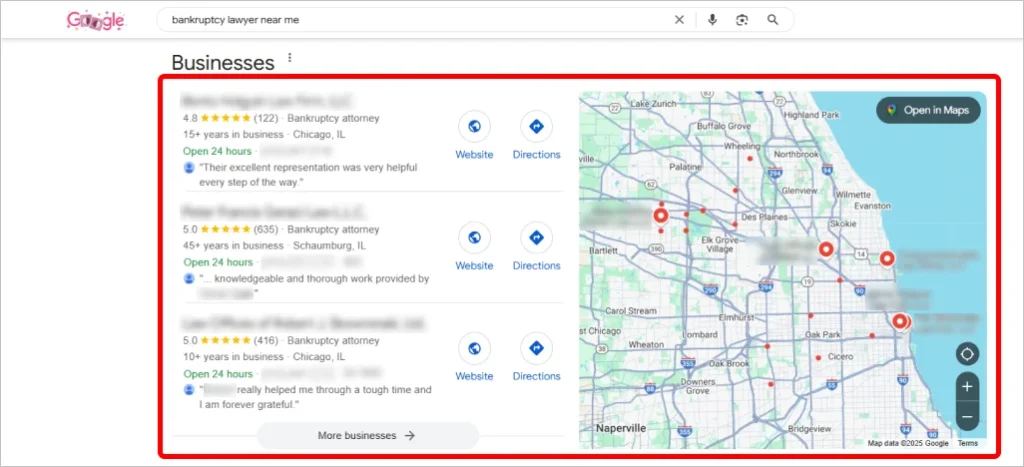
This is why local SEO strategies matter so much. Local SEO strategies help optimize your online presence to appear in local search results, especially in Google’s “Map Pack” and nearby listings. Here’s how bankruptcy attorneys should approach it:
Perfect Your Google Business Profile
Your Google Business Profile serves as your digital storefront. Make sure it’s fully claimed and properly optimized with:
- Correct name, address, and phone number (NAP)
- Appropriate categories (specifically “Bankruptcy Attorney,” not just “Lawyer”)
- A client-focused description that mentions Chapter 7, Chapter 13, and debt relief options
- Quality photos of your bankruptcy attorneys, office space, and firm logo
Optimizing your Google Business Profile not only improves your visibility in local search results but also directly on Google Maps. This can significantly influence your firm’s ability to attract local clients.
Share weekly updates using Google Posts—such as bankruptcy FAQs, successful cases, or free consultation events—to show activity and build relevance in your area.
Maintain Consistent Business Information
List your bankruptcy firm (with exactly the same NAP formatting) across legal and local directories:
- Avvo, Justia, FindLaw, Lawyers.com
- Your state’s bankruptcy attorney association
- Local Chamber of Commerce, Better Business Bureau
This consistency is crucial for effective legal marketing, as it helps improve your rankings and ensures potential clients can find your correct information across all platforms.
Improve your bankruptcy firm’s visibility and credibility by getting listed in the top legal directories for 2026. Check out the complete list!
Collect and Respond to Client Reviews
84% of people trust online reviews as much as personal recommendations.
Encourage satisfied bankruptcy clients to leave reviews on your Google Business Profile, Avvo, and Facebook. Always respond to reviews professionally, even negative ones. Google values this engagement, and potential bankruptcy clients pay close attention to how you interact with past clients.
Create Location-Specific Bankruptcy Content
If your content doesn’t reflect your city’s specific bankruptcy court procedures and bankruptcy process, Google won’t rank it for local searches. Create:
- City-specific bankruptcy service pages (“Chapter 7 Bankruptcy Attorney in [Your City]”)
- Blog posts about local bankruptcy exemptions and procedures
- Dedicated pages for each office location with local maps, bankruptcy court information, and directions
For local SEO success, attention to detail makes a significant difference. Perfect your local presence, and you won’t just outperform neighboring firms—you’ll become the go-to bankruptcy resource in your area.
6. Pay Attention to Technical SEO for Your Bankruptcy Website
You could have excellent bankruptcy content for your market, but if your site loads slowly, confuses visitors, or is difficult for search engines to crawl, it won’t rank well. Technical SEO forms the foundation of your entire online presence and significantly impacts your website’s performance. For many bankruptcy law firms, it’s the weakest link in their strategy.
Website Speed Is Critical
53% of mobile users abandon websites that take longer than 3 seconds to load. A slow page can cost you a potential client, especially when someone urgently searches for “emergency bankruptcy filing. Conforming to search engine algorithms is crucial, as they prioritize website speed to enhance user experience and relevancy on search engine results pages (SERPs). To improve speed:
- Compress and optimize images
- Streamline code (CSS, JavaScript, HTML)
- Use high-quality, secure hosting
- Avoid automatic video playback or intrusive pop-ups
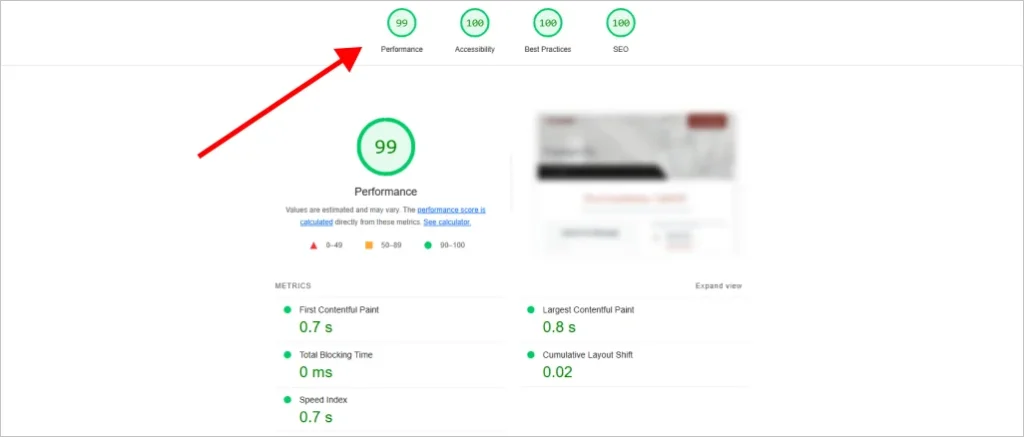
Mobile-Friendly Design Is Essential
Over 60% of Google searches happen on mobile devices. If your bankruptcy law firm’s site doesn’t load quickly, display properly, or allow users to easily tap contact buttons and forms on mobile, you’re not just frustrating potential clients—you’re losing them to competitors.
Implement Schema Markup
Schema markup helps Google understand and display your bankruptcy firm’s information, like reviews, business hours, and practice areas, directly in search results. Implementing schema markup is a crucial aspect of search engine optimization, as it makes your information more accessible to search engines. Implement LocalBusiness, Attorney, and FAQPage schema types for better visibility in bankruptcy-related searches.
Address Website Crawlability
If Google can’t find or understand your bankruptcy content, it won’t rank well. Ensure:
- Clear navigation between your bankruptcy service pages
- XML sitemap submitted through Google Search Console
- Clean, bankruptcy-keyword-rich URLs
- No broken links or orphaned pages
Addressing crawlability issues includes techniques like broken link building. This involves identifying broken or outdated links on relevant legal websites and reaching out to offer updated content from your firm’s website as a replacement, thereby generating valuable backlinks.
Regular website maintenance ensures that your site remains accessible and understandable to search engines, improving your overall SEO performance.
Tech Tip: Run a free website audit using tools like SEMrush, Surfer, or Screaming Frog. AI-powered audits can identify crawl issues, missing metadata, or speed problems—so you know exactly what to fix first.
7. Build Quality Links to Your Bankruptcy Website
Backlinks—links from other websites pointing to yours—remain one of the strongest ranking signals in Google’s algorithm. However, quality matters more than quantity.
For bankruptcy attorneys, link building is about establishing trust in a sensitive financial niche. When reputable, relevant sites with high domain authority link to your firm, you appear credible to both Google and potential bankruptcy clients.
Target Relevant, Authoritative Links
Focus on earning backlinks from respected sources within the financial and legal sectors, not low-quality blogs or irrelevant websites. Targeting authoritative links is a crucial part of off-page SEO, which enhances a website’s authority and visibility in search engine results. Good starting points include:
- Legal directories like Justia, Avvo, FindLaw, and Martindale-Hubbell
- Bankruptcy attorney associations and creditor rights organizations
- Financial news outlets featuring bankruptcy commentary or debt relief insights
According to research from Ahrefs, websites with strong backlink profiles rank significantly higher than those without, often by several positions for competitive bankruptcy terms.
Write Guest Posts Strategically
Publishing high-quality guest articles on respected legal or financial websites, also known as guest blogging, not only earns you valuable links but also positions you as a bankruptcy thought leader.
Propose topics related to bankruptcy trends, debt relief options, and financial recovery stories, always including a natural link back to your website.
Avoid Risky Shortcuts
Purchasing backlinks, using link farms, or overusing exact-match anchor text (like “best bankruptcy lawyer in [city]” in every link) can trigger Google penalties and harm your reputation. Stick to ethical, relationship-based tactics.
Use Smart Tools to Find Link Opportunities
AI-powered tools can analyze competitor backlinks and identify new guest posting or citation opportunities in the bankruptcy field. They can also help find unlinked mentions of your firm—an easy way to secure additional backlinks.
Remember that quality matters more than quantity. A few strong bankruptcy-specific backlinks will benefit you more than hundreds of low-value ones.
8. Create a Client-Focused Bankruptcy Website Design
Your content and backlinks alone won’t be effective if your website drives potential clients away.
Google monitors user behavior signals like bounce rate, time on site, and click-through rate. If users land on your bankruptcy page and quickly return to search results, Google interprets this as a negative signal and may lower your rankings.
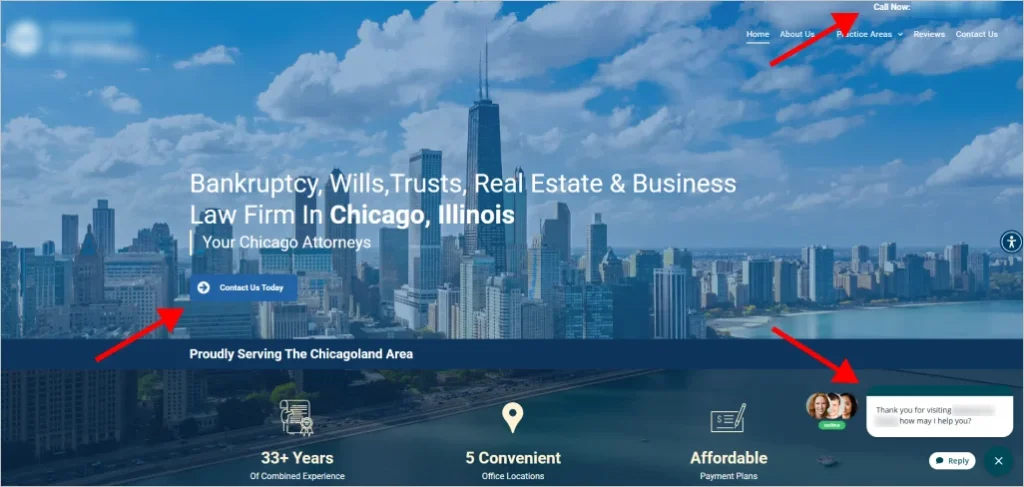
Design for Conversion, Not Just Appearance
Bankruptcy law websites must do more than look professional. They need to guide visitors toward taking action—whether that’s calling your office, completing a bankruptcy assessment form, or scheduling a free consultation.
Use clear headlines about debt relief, trust-building bankruptcy success stories, service explanations comparing Chapter 7 vs. Chapter 13, and strategically placed call-to-action buttons. An effective layout is intuitive, fast-loading, and designed with actual bankruptcy clients in mind.
Use Intelligent Chatbots for Lead Capture
AI-powered chatbots are no longer optional—they’re powerful conversion tools for bankruptcy attorneys.
When someone visits your site late at night after receiving a foreclosure notice, they won’t want to fill out a form and wait days for a response. A chatbot can engage them immediately, answer common bankruptcy questions, assess their financial situation, and even schedule an urgent consultation—all automatically.
Don’t settle for boring. Discover 60 lawyers websites that actually impress clients.
9. Monitor Your Bankruptcy Firm’s SEO Results
If you’re not tracking your SEO performance, you’re operating blindly—and potentially wasting thousands of dollars on strategies that aren’t effective for your bankruptcy practice.
Set Up Essential Tracking Tools
Start with the basics: Google Analytics and Google Search Console. These tools show you how people find your bankruptcy site, which keywords drive traffic, and where visitors leave your site. Without them, you can’t measure success or identify problems. Consider working with an experienced SEO agency to set up and manage these tools effectively.
Focus on Meaningful Metrics for Bankruptcy Lawyers
Don’t be distracted by superficial metrics like page views. For bankruptcy law firms, the key SEO performance indicators include:
- Organic traffic from potential clients in your bankruptcy court jurisdiction
- Click-through rates on bankruptcy-related search results
- Bounce rate and time spent on key pages like Chapter 7 and Chapter 13 services
- Form submissions and phone calls generated by organic search
- Keyword rankings for your bankruptcy practice areas and locations
These metrics tell you not just how visible you are, but whether your content is effectively converting visitors into bankruptcy consultations.
Create Actionable Reports
Monthly SEO reports should do more than display numbers—they should tell a story. Which bankruptcy terms are improving? Which pages aren’t performing well? What new debt relief content opportunities exist? Use this data to adjust your content strategy, site structure, and targeting.
Anticipate Future Trends
AI-powered tools can transform raw data into clear insights and even predict future performance for bankruptcy search terms. They highlight patterns and opportunities you might miss—and help you stay ahead of competing bankruptcy firms.
When you measure what truly matters, you can optimize what works best for your bankruptcy practice.

10. Integrate Complementary Marketing Channels
SEO is powerful for bankruptcy attorneys, but it works even better when combined with the right marketing mix. These complementary channels help maximize your visibility, nurture leads, and convert website visitors into bankruptcy clients.
Social Media for Bankruptcy Attorneys
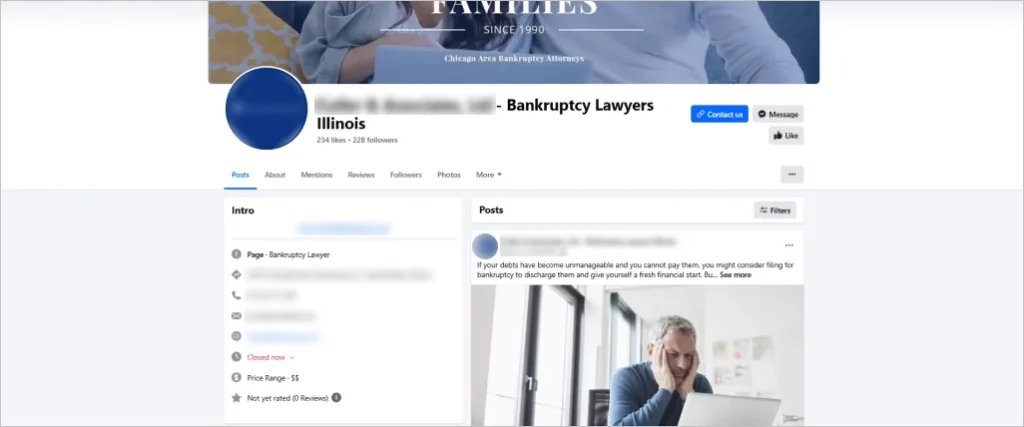
While social shares don’t directly improve your search rankings, they extend your bankruptcy content’s reach and build credibility. Platforms like LinkedIn and Facebook allow potential clients to see your bankruptcy expertise and supportive approach before contacting you. Educational content about bankruptcy performs particularly well.
PPC Advertising for Immediate Results
SEO takes time to develop. Pay-per-click (PPC) ads give your bankruptcy firm instant visibility for high-intent searches like “file bankruptcy today” or “stop foreclosure lawyer near me.” Use bankruptcy lawyer PPC to test bankruptcy-specific headlines and offers, then apply those insights to your SEO strategy.
Email Marketing for Client Nurturing
Not every potential client is ready to file for bankruptcy immediately. Email helps you stay top-of-mind through debt relief newsletters, bankruptcy FAQs, and client success stories, maintaining contact until they’re ready to take action.
Video Content for Bankruptcy Education
Videos increase time on site and engagement. Create short videos to answer bankruptcy FAQs, introduce your bankruptcy team, or explain the differences between Chapter 7 and Chapter 13. Upload them to YouTube and embed them on your site for additional SEO benefits.
You Became a Bankruptcy Lawyer to Help People in Financial Crisis—Is It Working?
You invested years of your life and significant resources in your legal education and bankruptcy specialization.
But right now, someone in your city is searching “bankruptcy lawyer near me”… and hiring your competitor—simply because they appeared in search results, and you didn’t.
At Comrade Digital Marketing, we help bankruptcy law firms stop losing revenue. Our team of SEO strategists, bankruptcy content writers, developers, and marketing experts puts your firm where it matters most—at the top of Google when highly motivated clients need debt relief urgently.
As a proven law firm SEO company, we’ve delivered up to 400% return on investment for bankruptcy attorneys nationwide.
If you’re tired of losing valuable bankruptcy cases to firms across the street:
Book your free SEO consultation today.
Let’s make sure the next bankruptcy filing goes to your firm.
